Spectral Index-Based Monitoring (2000–2017) in Lowland Forests to Evaluate the Effects of Climate Change
Abstract
:1. Introduction
1.1. The Study Area and the Delineation of Forests
1.2. The Environmental Problem in the Study Area: Consequences of Climate Change for the Landscape
1.3. Environmental Problems in the Study Area: Climate Change and Forests
2. Materials and Methods
2.1. Multispectral Data Products
2.2. The Usage and Application of Spectral Indices
NDVI and EVI as Vegetation Indices
2.3. PaDI as the Index of the Validation
3. Results and Discussion
3.1. Evaluation of Forest Vegetation with EVI/NDVI between 2000 and 2017
3.2. Analysis of Standardized Deviations from the EVI Mean
3.3. Validation of the EVI and NDVI Values
4. Conclusions
Author Contributions
Funding
Acknowledgments
Conflicts of Interest
References
- Copernicus—Europe’s Eyes on Earth. Available online: https://www.copernicus.eu/en (accessed on 2 July 2019).
- Early Warning and Environmental Monitoring Program (EWEM). Available online: https://earlywarning.usgs.gov/ (accessed on 2 July 2019).
- Burke, M.; Hsiang, S.M.; Miguel, E. Global non-linear effect of temperature on economic production. Nature 2015, 527, 235–239. [Google Scholar] [CrossRef] [PubMed]
- Rakonczai, J.; Fehér, Z. A klímaváltozás szerepe az Alföld talajvízkészleteinek időbeli változásaiban (The role of climate change in the changes of groundwater level in the Great Hungarian Plain). Hidrol. Közl. 2015, 95, 1–15. (In Hungarian) [Google Scholar]
- Newbold, T.; Hudson, L.N.; Arnell, A.P.; Contu, S.; De Palma, A.; Ferrier, S.; Hill, S.L.L.; Hoskins, A.J.; Lysenko, I.; Phillips, H.R.P.; et al. Has land use pushed terrestrial biodiversity beyond the planetary boundary? A global assessment. Science 2016, 353, 288–291. [Google Scholar] [CrossRef] [PubMed]
- Copernicus—High Resolution Layers. Available online: https://land.copernicus.eu/pan-european/high-resolution-layers (accessed on 2 July 2019).
- Mátyás, C. Forecasts needed for retreating forests. Nature 2010, 464, 1271. [Google Scholar] [CrossRef] [PubMed]
- Nemzeti Vidékstratégia 2012–2020 (National Landscape Strategy); Ministry of Agriculture and Rural Development: Budapest, Hungary, 2012; p. 136. Available online: http://www.terport.hu/webfm_send/2767 (accessed on 22 September 2019). (In Hungarian)
- Farkas, J.; Rakonczai, J.; Hoyk, E. Környezeti, gazdasági és társadalmi éghajlati sérülékenység: Esettanulmány a Dél-Alföldről (Environmental, economical and social climate vulnerability: A case study on the Hungarian South Great Plain). Tér Társad. 2015, 29, 149–174. (In Hungarian) [Google Scholar] [CrossRef]
- Copernicus—Corine Land Cover (CLC). Available online: https://land.copernicus.eu/pan-european/corine-land-cover (accessed on 2 July 2019).
- Digital Elevation Model over Europe (EU-DEM). Available online: http://data.europa.eu/euodp/data/dataset/data_eu-dem (accessed on 2 July 2019).
- Verbesselt, J.; Hyndman, R.; Newnham, G.; Culvenor, D. Detecting trend and seasonal changes in satellite image time series. Remote Sens. Environ. 2010, 114, 106–115. [Google Scholar] [CrossRef]
- Xin, Q.; Olofsson, P.; Zhu, Z.; Tan, B.; Woodcock, C.E. Toward near real-time monitoring of forest disturbance by fusion of MODIS and Landsat data. Remote Sens. Environ. 2013, 135, 234–247. [Google Scholar] [CrossRef]
- Lunetta, R.S.; Knight, J.F.; Ediriwickrema, J.; Lyon, J.G.; Worthy, L.D. Land-cover change detection using multi-temporal MODIS NDVI data. Remote Sens. Environ. 2006, 105, 142–154. [Google Scholar] [CrossRef]
- Távérzékelésen Alapuló Erdőállapot Monitorozó Rendszer (Hungarian Forestry Monitoring Based on Remote Sensing, TEMRE). Available online: http://klima.erti.hu/home/erdoallapot-monitoring-2/ (accessed on 2 July 2019). (In Hungarian).
- Kern, A.; Marjanovic, H.; Dobor, L.; Anic, M.; Hlásny, T.; Barcza, Z. Identification of Years with Extreme Vegetation State in Central Europe Based on Remote Sensing and Meteorological Data. South East Eur. For. 2017, 8, 1–20. [Google Scholar] [CrossRef]
- GISS Surface Temperature Analysis (GISTEMP). NASA Goddard Institute for Space Studies. Available online: https://data.giss.nasa.gov/gistemp/ (accessed on 2 July 2019).
- Wilson, R.; Anchukaitis, K.; Briffa, K.R.; Büntgen, U.; Cook, E.; D’Arrigo, R.; Davi, N.; Esper, J.; Frank, D.; Gunnarson, B.; et al. Last millennium northern hemisphere summer temperatures from tree rings. Part I: The long term context. Quat. Sci. Rev. 2016, 134, 1–18. [Google Scholar] [CrossRef]
- Csorba, P.; Blanka, V.; Vass, R.; Nagy, R.; Mezősi, G.; Meyer, B. Hazai tájak működésének veszélyeztetettsége új klímaváltozási előrejelzés alapján (Sensitivity of the Hungarian mesolandscapes according to the modelled climate change). Földr. Közl. 2012, 136, 237–253. (In Hungarian) [Google Scholar]
- Rakonczai, J.; Deák, J.Á.; Ladányi, Z.; Fehér, Z. Indicators of climate change in the landscape: Investigation of the soil—Groundwater—Vegetation connection system in the Great Hungarian Plain. In Review of Climate Change Research Program at the University of Szeged; Rakonczai, J., Ladányi, Z., Eds.; Institute of Geography and Geology: Szeged, Hungary, 2012; pp. 41–59. [Google Scholar]
- Kovács, F.; van Leeuwen, B.; Ladányi, Z.; Rakonczai, J.; Gulácsi, A. Regionális léptékű aszálymonitoringot támogató vegetáció—És talajnedvesség értékelés MODIS adatok alapján (Vegetation and soil moisture assessment based on MODIS data to support regional drought monitoring). Földr. Közl. 2017, 141, 14–29. (In Hungarian) [Google Scholar]
- Lakatos, M.; Bihari, Z.; Szentimrey, T. A klímaváltozás magyarországi jelei (Observed climate change in Hungary). Légkör 2014, 59, 158–163. (In Hungarian) [Google Scholar]
- Bihari, Z.; Babolcsay, G.; Bartholy, J.; Ferenczi, Z.; Kerényi, J.; Haszpra, L.; Újváry, K.; Kovács, T.; Lakatos, M.; Németh, Á.; et al. Éghajlat (Climate). In Magyarország Nemzeti Atlasza 2. Kötet: Természeti Környezet (Hungarian National Atlas, Nature Environment); Kocsis, K., Horváth, G., Keresztesi, Z., Nemerkényi, Z., Eds.; MTA CSFK Földrajztudományi Intézet: Budapest, Hungary, 2018; pp. 58–69. (In Hungarian) [Google Scholar]
- Bartholy, J.; Horányi, A.; Krüzselyi, I.; Pieczka, I.; Pongrácz, R.; Szabó, P.; Szépszó, G.; Torma, C.; Radics, K.; Szentimrey, T.; et al. A várható éghajlatváltozás dinamikus modelleredmények alapján (Expected climate change based on results of dynamic modell). In Klímaváltozás—2011; Bartholy, J., Bozó, L., Haszpra, L., Eds.; MTA-ELTE Meteorológia Tanszék: Budapest, Hungary, 2011; pp. 170–235. (In Hungarian) [Google Scholar]
- Mezősi, G.; Blanka, V.; Ladányi, Z.; Bata, T.; Urdea, P.; Frank, A.; Meyer, B. Expected mid- and long-term changes in drought hazard for the South-Eastern Carpathian Basin. Carpathian J. Earth Environ. Sci. 2016, 11, 355–366. [Google Scholar]
- Integrált Vízháztartási Tájékoztatók (Hungarian Integrated Water Management Bulletin). Available online: http://www.vizugy.hu/index.php?module=documents&programelemid=108 (accessed on 2 July 2019). (In Hungarian).
- Fiala, K.; Blanka, V.; Ladányi, Z.; Szilassi, P.; Benyhe, B.; Dolinaj, D.; Pálfai, I. Drought severity and its effect on agricultural production in the Hungarian-Serbian cross-border area. J. Environ. Geogr. 2014, 7, 43–51. [Google Scholar] [CrossRef]
- Kovács, F. GIS analysis of short and long term hydrogeographical changes on a nature conservation area affected by aridification. Carpathian J. Earth Environ. Sci. 2013, 8, 97–108. [Google Scholar]
- Központi Statisztikai Hivatal (Hungarian Central Statistical Office). Available online: https://www.ksh.hu/docs/hun/xstadat/xstadat_eves/i_uw002.html (accessed on 2 July 2019). (In Hungarian).
- Hunkár, M.; Vincze, E.; Szenyán, I.; Dunkel, Z. Application of phenological observations in agrometeorological models and climate change research. Q. J. Hung. Meteorol. Serv. 2012, 116, 195–209. [Google Scholar]
- Szabó, B.; Vincze, E.; Czúcz, B. Flowering phenological changes in relation to climate change in Hungary. Int. J. Biometeorol. 2016, 60, 1347–1356. [Google Scholar] [CrossRef]
- Czúcz, B.; Molnár, Z.; Horváth, F.; Botta-Dukát, Z. The natural capital index of Hungary. Acta Bot. Hung. 2008, 50 (Suppl. 1), 161–177. [Google Scholar] [CrossRef]
- Pálfai, I. A Duna-Tisza Közi Hátság Vízháztartási Sajátosságai (Peculiarities of water household in Danube-Tisza Interfluve). Hidrol. Közlöny 2010, 90, 40–44. (In Hungarian) [Google Scholar]
- Völgyesi, I. A Homokhátság Felszínalatti Vízháztartása. Vízpótlási és Visszatartási Lehetőségek (Groundwater Household on the Sandy Ridge). In Proceedings of the MHT XXIV, Országos Vándorgyűlés Kiadványa, Pécs, Hungary, 5–6 July 2006; pp. 1–12. (In Hungarian). [Google Scholar]
- Kristóf, D.; Pataki, R.; Neidert, D.; Nagy, Z.; Pintér, K. Integrating temporal and spectral information from low-resolution MODIS and high-resolution optical satellite images: Two Hungarian case studies. In Proceedings of the SPIE—The International Society for Optical Engineering, Florence, Italy, 17–20 September 2007; Volume 6742. [Google Scholar] [CrossRef]
- Solano, R.; Didan, K.; Jacobson, A.; Huete, A. MODIS Vegetation Index User’s Guide; MOD13 Series; Vegetation Index and Phenology Lab., University of Arizona: Tucson, AZ, USA, 2010; p. 42. Available online: https://vip.arizona.edu/documents/MODIS/MODIS_VI_UsersGuide_01_2012.pdf (accessed on 22 September 2019).
- Hmimina, G.; Dufrêne, E.; Pontailler, J.-Y.; Delpierre, N.; Aubinet, M.; Caquet, B.; de Grandcourt, A.; Burban, B.; Flechard, C.; Granier, A.; et al. Evaluation of the potential of MODIS satellite data to predict vegetation phenology in different biomes: An investigation using ground-based NDVI measurements. Remote Sens. Environ. 2013, 132, 145–158. [Google Scholar] [CrossRef]
- Gulácsi, A.; Kovács, F. Drought monitoring with spectral indices calculated from MODIS satellite images in Hungary. J. Environ. Geogr. 2015, 8, 11–19. [Google Scholar] [CrossRef]
- Xie, Y.; Sha, Z.; Yu, M. Remote sensing imagery in vegetation mapping: A review. J. Plant Ecol. 2008, 1, 9–23. [Google Scholar] [CrossRef]
- Huete, A.; Didan, K.; Miura, T.; Rodriguez, E.P.; Gao, X.; Ferreira, L.G. Overview of the radiometric and biophysical performance of the MODIS vegetation indices. Remote Sens. Environ. 2002, 83, 195–213. [Google Scholar] [CrossRef]
- Cuba, N.; Rogan, J.; Christman, Z.; Williams, C.A.; Schneider, L.C.; Lawrence, D.; Millones, M. Modelling dry season deciduousness in Mexican Yucatán forest using MODIS EVI data (2000–2011). GISci. Remote Sens. 2013, 50, 26–49. [Google Scholar] [CrossRef]
- LSDS Science Research and Development (LSRD), USGS. Available online: https://espa.cr.usgs.gov/ (accessed on 2 July 2019).
- Bannari, A.; Morin, D.; Bonn, F.; Huete, A.R. A review of vegetation indices. Remote Sens. Rev. 1995, 13, 95–120. [Google Scholar] [CrossRef]
- Gulácsi, A.; Kovács, F. Drought monitoring of forest vegetation using MODIS-based normalized difference drought index in Hungary. Hung. Geogr. Bull. 2018, 67, 29–42. [Google Scholar] [CrossRef] [Green Version]
- Ahl, D.E.; Stith, T.G.; Sean, N.B.; Nikolay, V.S.; Myneni, R.B.; Knyazikhin, Y. Monitoring spring canopy phenology of a deciduous broadleaf forest using MODIS. Remote Sens. Environ. 2006, 104, 88–95. [Google Scholar] [CrossRef] [Green Version]
- Borgogno-Mondino, E.; Lessio, A.; Gomarasca, M. A fast operative method for NDVI uncertainty estimation and its role in vegetation analysis. Eur. J. Remote Sens. 2016, 49, 137–156. [Google Scholar] [CrossRef]
- Li, Z.; Li, X.; Wei, D.; Xu, X.; Wang, H. An assessment of correlation on MODIS-NDVI and EVI with natural vegetation coverage in Northern Hebei Province, China. Procedia Environ. Sci. 2010, 2, 964–969. [Google Scholar] [CrossRef] [Green Version]
- Szabó, S.; Elemér, L.; Kovács, Z.; Püspöki, Z.; Kertész, Á.; Singh, S.K.; Balázs, B. NDVI dynamics as reflected in climatic variables: Spatial and temporal trends—A case study of Hungary. GISci. Remote Sens. 2019, 56, 624–644. [Google Scholar] [CrossRef]
- Ladányi, Z.; Blanka, V. Relationship of drought and biomass production. In Drought and Water Management in South Hungary and Vojvodina; Blanka, V., Ladányi, Z., Eds.; Department of Physical Geography and Geoinformatics, University of Szeged: Szeged, Hungary, 2014; pp. 132–135. [Google Scholar]
- Kovács, F. Assessment of regional variations in biomass production using satellite image analysis between 1992 and 2004. Trans. GIS 2007, 11, 911–926. [Google Scholar] [CrossRef]
- Szalai, S.; Auer, I.; Hiebl, J.; Milkovich, J.; Radim, T.; Stepanek, P.; Zahradnicek, P.; Bihari, Z.; Lakatos, M.; Szentimrey, T. Climate of the Greater Carpathian Region. Final Technical Report. 2013. Available online: http://www.carpatclim-eu.org (accessed on 22 September 2019).
- Kovács, F. NDVI/EVI monitoring in forest areas to assessment the climate change effects in Hungarian Great Plain from 2000. In Proceedings of the SPIE 10783, Remote Sensing for Agriculture, Ecosystems, and Hydrology XX, 107831H, Berlin, Germany, 10 October 2018. [Google Scholar] [CrossRef]
- Menzel, A.; Sparks, T.H.; Estrella, N.; Koch, E.; Aasa, A.; Agas, R.; Alm-Kübler, K.; Bissolli, P.; Braslavská, O.; Briede, A.; et al. European phenological response to climate change matches the warming pattern. Glob. Chang. Biol. 2006, 12, 1969–1976. [Google Scholar] [CrossRef]
- Hlásny, T.; Barka, I.; Sitková, Z.; Bucha, T.; Konopka, M.; Lukác, M. MODIS-based vegetation index has sufficient sensitivity to indicate stand-level intra-seasonal climatic stress in oak and beech forests. Ann. For. Sci. 2015, 72, 109–125. [Google Scholar] [CrossRef]


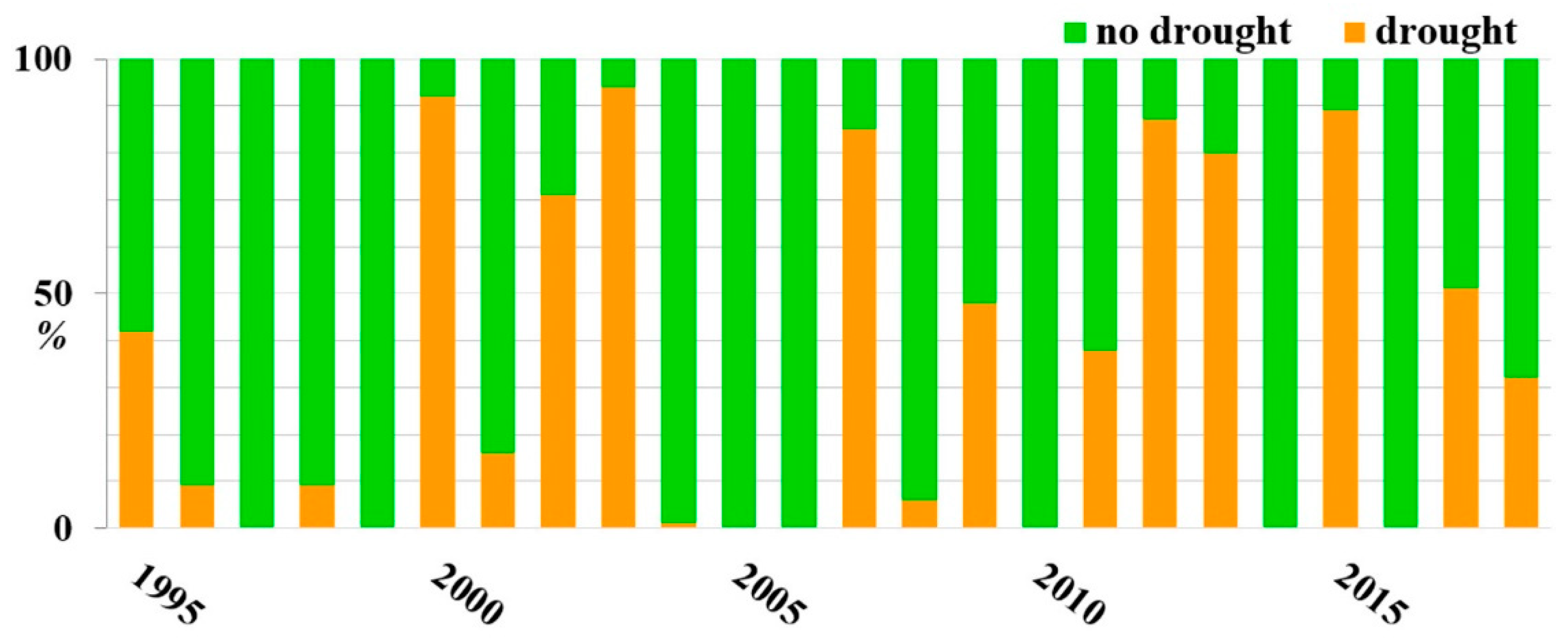
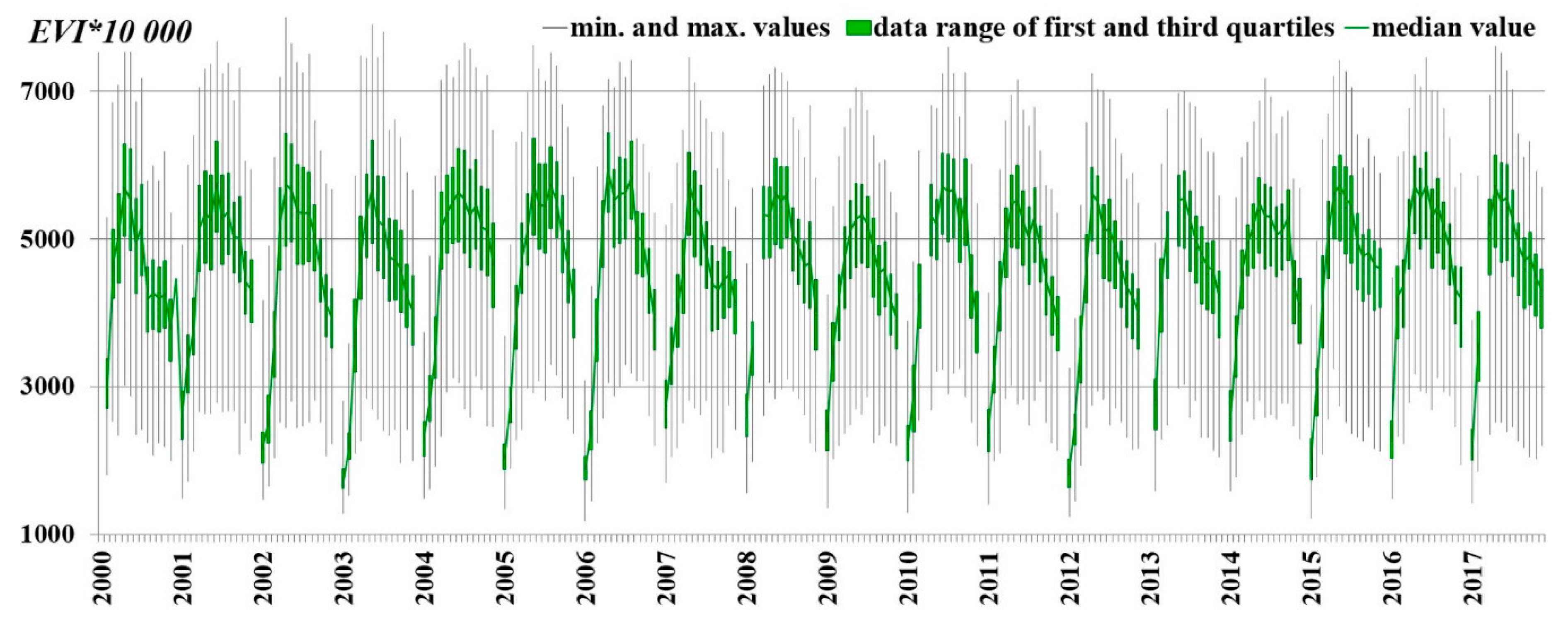



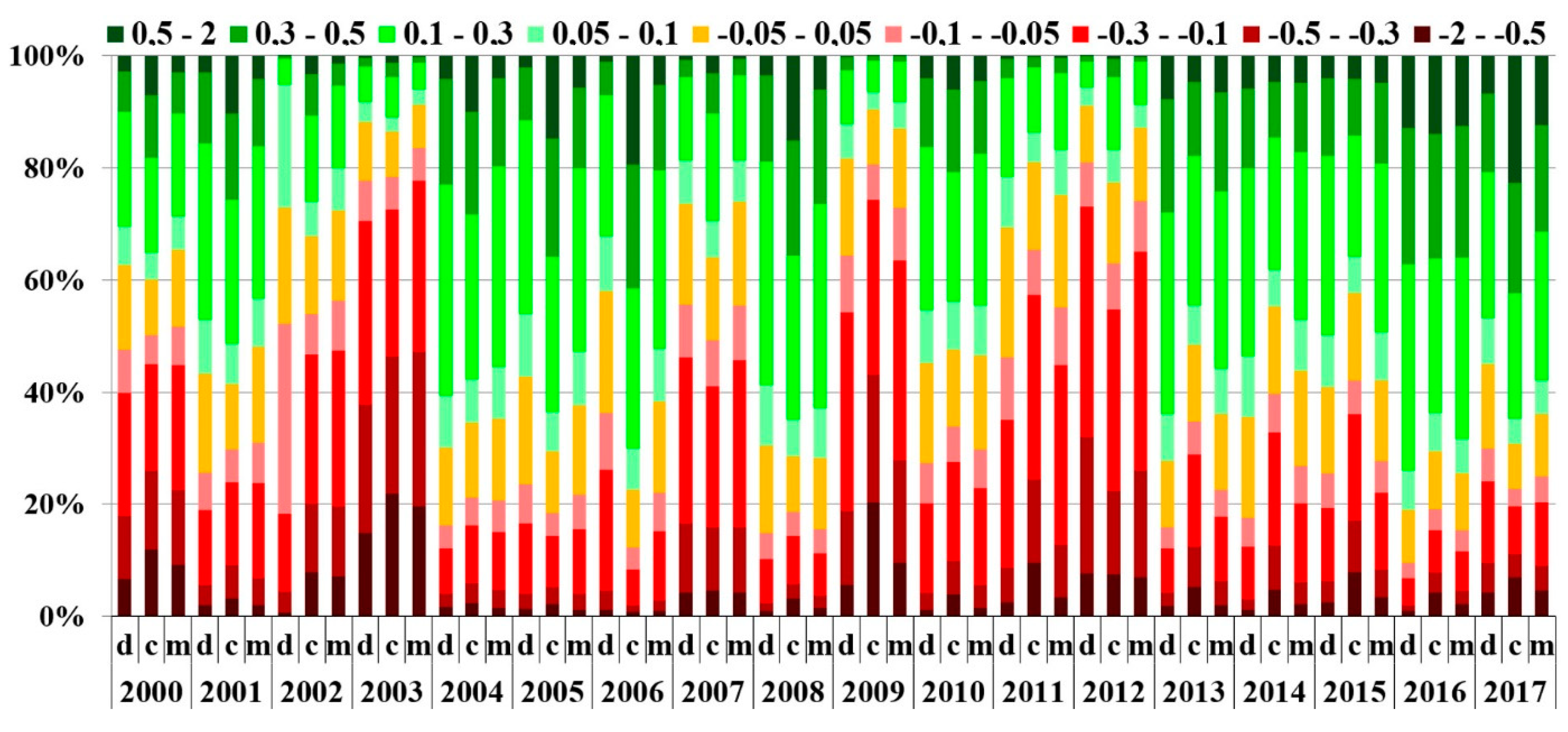
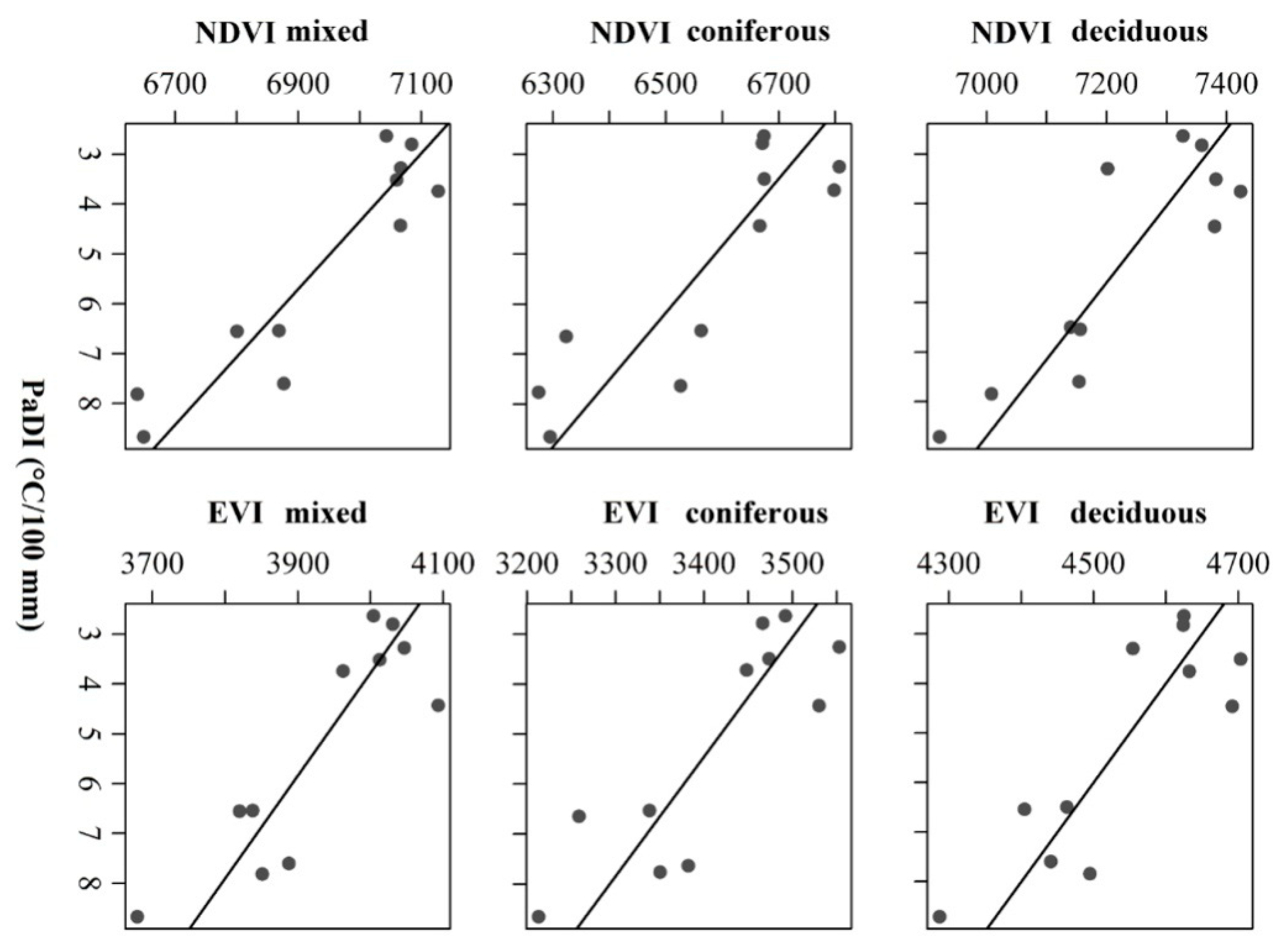
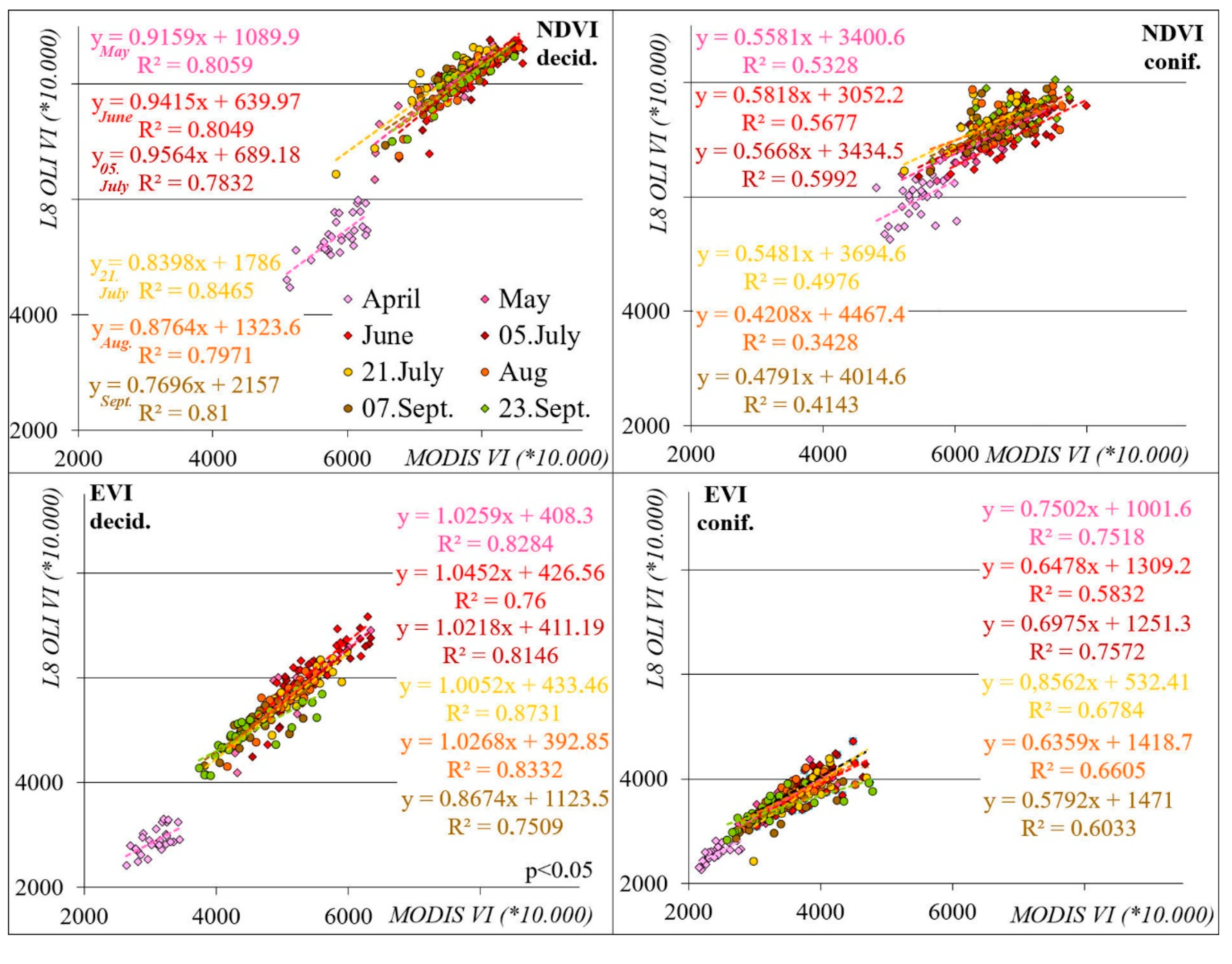
© 2019 by the authors. Licensee MDPI, Basel, Switzerland. This article is an open access article distributed under the terms and conditions of the Creative Commons Attribution (CC BY) license (http://creativecommons.org/licenses/by/4.0/).
Share and Cite
Kovács, F.; Gulácsi, A. Spectral Index-Based Monitoring (2000–2017) in Lowland Forests to Evaluate the Effects of Climate Change. Geosciences 2019, 9, 411. https://doi.org/10.3390/geosciences9100411
Kovács F, Gulácsi A. Spectral Index-Based Monitoring (2000–2017) in Lowland Forests to Evaluate the Effects of Climate Change. Geosciences. 2019; 9(10):411. https://doi.org/10.3390/geosciences9100411
Chicago/Turabian StyleKovács, Ferenc, and András Gulácsi. 2019. "Spectral Index-Based Monitoring (2000–2017) in Lowland Forests to Evaluate the Effects of Climate Change" Geosciences 9, no. 10: 411. https://doi.org/10.3390/geosciences9100411




